|
Trekkers Guide to the Galaxy
- Annapurna Sanctuary
Ahhhhhh, trekking, the simple act of putting one foot
in front of the other, over and over and over again. Reducing time to the rhythm of your body and letting
your mind wander across an infinite landscape. You exchange your stress and worries for simpler needs-
eating and sleeping and how far til we rest again. You learn to listen to your body, then exceed the limits you would normally post. Do something crazy
like spend nine days trekking 150 miles, climbing up
and down repeatedly until you have ascended to
15,000 feet and the air is so thin you can actually
see the difference. Trekking forces you to confront
your limitations and challenges you to blow them away.
In short, it exceeded all our expectations.
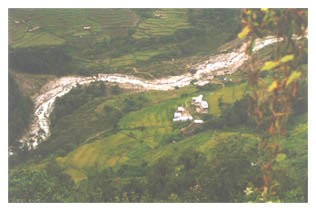
Basics:
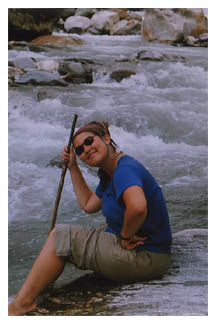 To begin trekking you must ... To begin trekking you must ...
Get thee to Nepal
ASAP!
Do not pass go, do not try to arrange a trek from the
US (unless you truly enjoy being fleeced) just hop a
plane (roundtrip from Chicago as little as $900) and
arrive in the big city of Kathmandu. Decide how long and where you want to go.
As we already mentioned, Everest is big around here (must be
something to do with being the tallest point on earth) but is also difficult and long. But what
a lot of people forget is that here in
Nepal, Everest doesn't look that big
next to the second and third tallest mountains in the world, shorter by just a few hundred feet. So there is
a lot
of Himalaya and there will be an area just suited to
you.
We chose the Annapurna Sanctuary because it seemed to
offer the biggest bang for your buck, meaning it is
pretty much the most remarkable scenery and
incredible
terrain that you can get in only 8-10 days. The
Sanctuary is so named because you climb up to a ring
of some of the tallest mountains in the world, climb through a small gorge between two peaks and
emerge in a valley (if you can call a plateau at
15,000
feet a valley) completely surrounded by majestic
eternally snow-capped peaks. The trek up takes you
through an incredible variety of terrain, from rice-covered hill terraces to heavy forested glades to
tropical jungle and finally to a barren
oxygen deprived
no-mans land that is sacred and holy to the people of
Nepal.
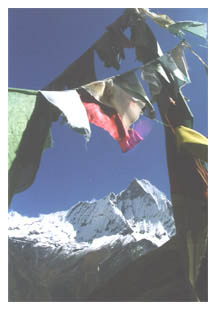 View
of Fishtail from within the Annapurna Sanctuary View
of Fishtail from within the Annapurna Sanctuary
The
Sanctuary is an amazing place. Sacred, serene, barren, hostile, and just
plain closer to God. No one lives there for any length of time, just a
few lodge owners who vacate when the tourists do. While many stay at MBC
and just hike up to the Sanctuary before dawn, snap a pic of the sun
rising and make it back to MBC for breakfast, we wanted to spend some
time breathing in the rarified air. Beyond base camp is a jumble of rock
stupas, pile of rocks, large and small topped with prayer flags. Surely,
God would hear these prayers, so close to his abode. I was struck by the
silence. Just the snap of prayer flags as the wind whipped through them.
And the occasional distant roar of a small avalanche moving down the
face of Annapurna South.
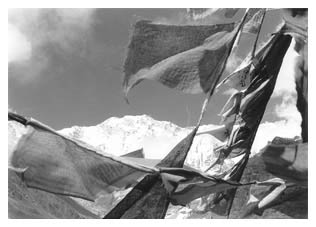
Arranging the trek:
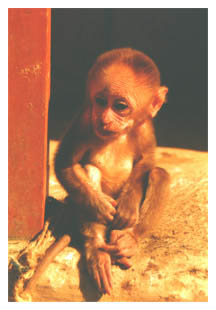 First, a couple of decisions to make. Are you a do
it yourselfer. If so, just buy a map and go. The trails are pretty cut and dry and
locals along the way will certainly point you in the
right direction (if only to get you out of their
fields.) If you like to camp, better yet, carry your
gear and then you can rest at your leisure anywhere
along the trails. There are tons of people who do it
this way every year and you will most certainly have
company if you want it. First, a couple of decisions to make. Are you a do
it yourselfer. If so, just buy a map and go. The trails are pretty cut and dry and
locals along the way will certainly point you in the
right direction (if only to get you out of their
fields.) If you like to camp, better yet, carry your
gear and then you can rest at your leisure anywhere
along the trails. There are tons of people who do it
this way every year and you will most certainly have
company if you want it.
And even a few monkeys...
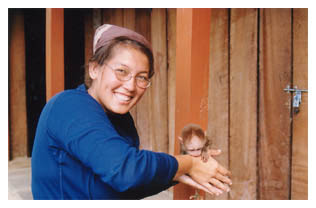
If you prefer a little bit of guidance, do as we did
and hire a guide and a porter, or one or the other.
We hired a porter because, while we did want to
challenge ourselves, we didn't exactly want to give
up
on the first big hill, collapsing under the weight of
our packs. Plus, it is very good for the local
economy.
Many of the people in Nepal, who have spent a
lifetime climbing up and down the mountains, make good livings
as porters. Just make sure you give him a humane
decent-sized pack. The three of us packed all our
gear into one backpack which we gave to Euro (he was
our
awesome porter) and then we each carried a more than
managable daypack. But we saw so many porters along
the
trail burdened by an ungodly amount of stuff just
because their clients were to cheap to just hire
another porter.
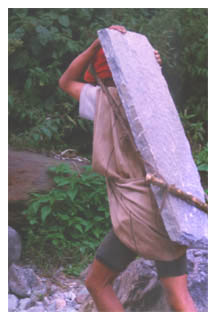 Nepalis are unused to carrying a back
pack the way we do, with shoulder harness and waist
straps. Instead they carry items using a harness or tumpline as
they call it, that
circles under the load and then around their
forehead.
They clutch the strap at either side of their face
to keep it level and centered, as a slight twist to
either side will violently wrench their neck. And the most amazing thing is that
they carry loads of up to 120 lbs in this manner with
nary a misstep. While us westerners prance around in
all the latest hi-tech hiking paraphenalia, they do
it
in FLIP-FLOPS, yeah the flimsy foam rubber ones for
the
shower. We even saw some barefoot with soles harder
than your hiking boot tread. More than a few porters
we saw carried THREE large backpacks in this manner,
two side by side and one across the top. It was
completely disgusting and we wanted to shoot the
foriegners who gave them the load. Because, these
days
the going rate for a porter is $8 a day. Nepalis are unused to carrying a back
pack the way we do, with shoulder harness and waist
straps. Instead they carry items using a harness or tumpline as
they call it, that
circles under the load and then around their
forehead.
They clutch the strap at either side of their face
to keep it level and centered, as a slight twist to
either side will violently wrench their neck. And the most amazing thing is that
they carry loads of up to 120 lbs in this manner with
nary a misstep. While us westerners prance around in
all the latest hi-tech hiking paraphenalia, they do
it
in FLIP-FLOPS, yeah the flimsy foam rubber ones for
the
shower. We even saw some barefoot with soles harder
than your hiking boot tread. More than a few porters
we saw carried THREE large backpacks in this manner,
two side by side and one across the top. It was
completely disgusting and we wanted to shoot the
foriegners who gave them the load. Because, these
days
the going rate for a porter is $8 a day.
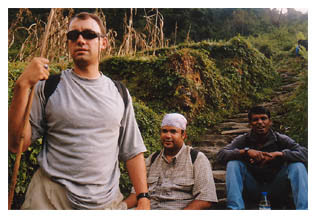
Doug,
T Augustus and Devi taking a break
We also hired a guide because porters generally do
not
speak English (occasionally you will come across
a combo guide/porter) and he shows you the way and
can explain some things along the way. But a good guide can point
out the most interesting things, introduce you to the
locals, teach you phrases in Nepali, share culture and festivals
with you and otherwise
enrich your experience and open Nepal to you like a flower. Devi, our guide was great. By
the end of the trek, Ann could converse and hold a
short conversation with nNpalis along the way. And he
was just great company for ten days in the
wilderness.
We got lucky. Devi and Euro were
incredible. Devi was hilarious, singing Nepali folk
songs, teaching us crazy variations on gin rummy as
well as Nepali swear words, and taunting us by
telling us how long it would take a Nepali to climb
the hill that we just spent all day climbing. And he was also
invaluable, running ahead to secure lodging in smaller places with fewer
beds available, when we knew we couldn't go step further. Helping with
our daypacks when we needed the extra push, and even helping bandage
feet, even though we protested vehemently. And always encouraging and
staying with the slowest member of our group.
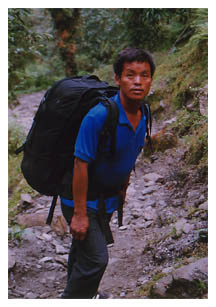 Euro
was a human metronome, his pace, an almost unreal
rhythm that was as dependable as a timex. We would try to shake him up at times. T would drop
his sunglasses and then take off running, but before
he had taken three steps, Euro was next to him
handing over his sunglasses. He's the main reason T made it
up to ABC, not in
words but in his reassuring presence. Solid
as a rock, even when he is massaging the cramps out of T's legs. No...it
was a great group and we had a lot of fun. Euro
was a human metronome, his pace, an almost unreal
rhythm that was as dependable as a timex. We would try to shake him up at times. T would drop
his sunglasses and then take off running, but before
he had taken three steps, Euro was next to him
handing over his sunglasses. He's the main reason T made it
up to ABC, not in
words but in his reassuring presence. Solid
as a rock, even when he is massaging the cramps out of T's legs. No...it
was a great group and we had a lot of fun.
Details, details:
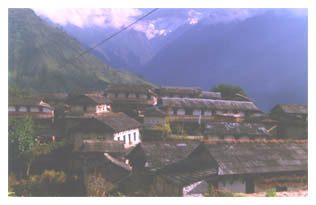
Do you prefer the comfort of a bed, no matter how
loose
the term, rather than the good hard earth and a sleeping bag. Then you want a tea-house trek. Small
lodges built at certain intervals along the trek.
Some approach rustic lodge proportions, while others
are merely a family home opened up to guests. There
is
always room (well, there may be no actual rooms but
you are welcome to sleep on the floor in the main
room
by the fire.) They are like the inns of old, small
un-heated, un-lighted closet-like rooms with beds
adjoining the main common room with a big table, a
fire
to warm, and a kitchen off it. Everyone gathers there
at night, talking, eating and drinking, playing cards
and games, and generally getting along very well with
the motley crew who happens to be tossed together.
The higher you go, the colder and more rustic it
gets,
yet the people seem nicer and nicer.
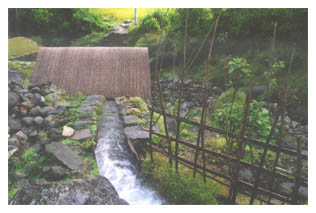
now
that's got be a cold shower...
Oh, and there is nothing like bathing out of a bucket
at 15,000 feet in an unheated outhouse when it is
20 degrees (inside the outhouse) with a wind-chill of
ZERO! You have a bucket of boiling hot water and a
faucet tap of bone-numbingly ice cold water and you
try to somehow meld the two together into a
body-tolerable concentration that you pour over
yourself while trying not to splash and drown out
your
lone candle. But the best are those few seconds after
you have poured the last bit of bathwater over
yourself and you are frantically trying to dry off
and put on your clothes before becoming hypothermic.
I found actually standing in the bucket helps to recycle the water and
keep your feet warm. Now that's a tip for ya!
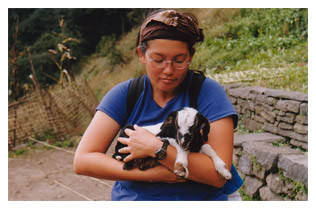
I
made all kinds of friend on the trail
Ahhhhhh, rustic.
Up in the mountains, you can get anything food and
drink-wise as long as you are willing to pay. Up
at the Annapurna Base Camp in the Sanctuary, you can
get a snickers bar for $1.50. The higher you go, the
prices quickly rise, as everything must be carried
up on the backs of porters. We made the environmentally
sound decision not to buy bottled water, as bottle
garbage is becoming a big problem up there. Instead,
we opted for the delicious taste of iodine-sanitized
mountain stream-water. Even water that flows out of
the mighty Himalayas might give you a bad case of runs
when your system is not used to it. But when you're
exhausted and thirsty, we promise, it tastes great!
In the Annapurna Area, all prices and menu are fixed for a certain
area. There is no difference at any lodges, instead you look for
quality, ambience, facilities etc and your guide has good
recommendations, usually the best food, etc. All total, our daily expenditures came to about
$17
a day. That's guide, porter, food & drink, and
lodging
along the way, per person (we split the cost of guide and porter
among three people) Again, do not arrange from
the US. The same thing will probably cost $100 a day.
Don't worry about paying for guide/porter food and lodging. Lodging
doesn't cost anything because they all stay in the common room or in
special dorm style accommodations just for locals. And it is better to
work out a deal ahead of time with then about food. If you are seen
paying for their dhal bhat along the way, the lodges will charge the
tourist price. Instead, it is generous to offer to reimburse them at the
end of the trip. And also, don't forget to invite them to share in some
continental food and beer, although that does go right on your bill
(There is no local price for western food) It'll be a good time.
Timing:
Actually trekking has a small window of
opportunity. Most come from september through
november. September because it is just after the
monsoon and the air is clean and crystal clear
affording the most incredible views of the mountains.
By december, it is just too cold up there and
many places are unpassable because of snow and
the chance of avalanches. Some people also come in
March to May but by then, it has been dry for so long
that the air is somewhat hazy and blocks views.
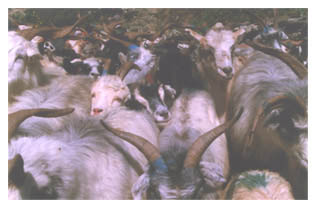
Best of all, time it during a Nepali festival.
We lucked out and arrived right at the start of the
largest festival of the year, Dasain. it is devoted
to the bloodthirtsy incarnation of Parvati, known
affectionately as Kali. She demands blood sacrifices
and the whole country is awash in blood, literally.
There is a wholesale slaughter of goats and buffalos
everywhere. When we started the trek, we saw herds
and herds of goats being out of the mountains down
into the towns to be sold. Every household must
sacrifice a goat, and sprinkle all their stuff with
blood for good luck in the new year. Many times we
had to wade through endless number of goats, all
bleeting madly seemingly sensing their fate. Along
the
way we saw villagers bustling about cleaning their
homes in preparation and swinging on huge bamboo
swings constructed just for the festival.
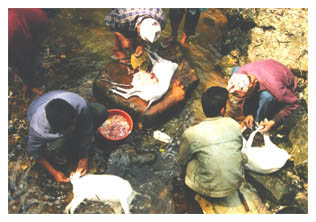
One night at a lodge, we gathered
around to watch the lodge owner and his family
slaughter a goat. I realized I much rather pick up
my goatmeat at Dominicks, fresh or not. Watching them
skin the poor creature and separate out his guts into
various pans for cooking. The whole scene was
watched over by our poor friends head, sitting off
to the side. Later, remembering the great taste
of goat meat at home, asked if I could join in,
and have a taste. Well, the lodge owner was so
delighted that a little while later, he proudly
served us, a steaming plate of goat, well, actually
goat parts. No sign of any muscle, but rather,
an interesting assortment that probably included
the kidneys, liver, heart, brain, tongue, intestines and other
unmentionables. And because we were special guests,
it was served plain, no spices or anything to get in
the way, just lightly fried. Everyone stood around to watch us eat it.
YUM YUM. We did, because it's a mortal sin to offend.
But we won't talk about the taste. Later, the Nepalis
sat down to a dinner of goat part curry. Devi gave
me some and it was delicious. To make it last longer,
they only use the parts to flavor a curry. That means our
meal was all the more special. Now after getting
up close and personal with a goat internals, we later
recognized that some of the decorations at homes
and around town were actually intestine streamers,
blown up and strung out. We should try that on our
Xmas tree.
Last,
but not least:
Many
people wonder if they are fit enough to try a trek. Well, we have the
answer. It is possible for anyone if they are willing to put up with a
certain amount of pain for alot of gain. Seriously...being fit will make
the journey a whole lot more enjoyable, but even if you don't fall into
that classification, you should still think about it. Just go slow! Our
friend T Augustus joined us on our RTW trip in India, about two weeks
before we set off trekking. T liked to say he had a body by bohemia,
sculpted through numerous rounds of drinking Mexican Bohemia Beer.
Straight from a serious desk job to the highest peaks in the world, he
had no idea what we had in store when he joined us. And I am happy to
say, he made it to ABC with a maximum of pain. On the very first day on
the very first hill just before lunch was when we had our first inkling
of the type of journey it was to be. The steep climb was an hour
straight up. But he plugged on, slow but sure, and poor Euro taking to
massaging the grindingly painful leg cramps. This is, by all means, an
extreme case, of someone who did not prepare one iota for a trek but
made it anyway. And I know he would want to dedicate this
installment to Euro, who without his unflagging devotion to getting T's
ass up the mountain, we would not be writing this installment.
Anyway, that's about wraps up Ann's & Doug's
Guide to
Trekking. Please email with questions and comments,
and hopefully you will get up and JUST DO IT!
Next time: Hippidom meets the Himalayas in
Kathmandu!
Over and out, good Buddies
Ann & Doug
index | back
| next |
